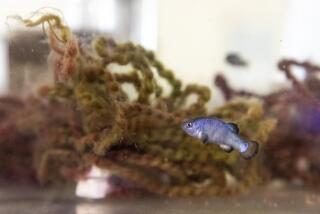Endangered desert species cling to existence

<p>About 200 Amargosa voles cling to existence in the marshes east of Death Valley National Park. State and federal biologists hope to help save the voles and other threatened and endangered desert species from extinction.</p>
TECOPA, Calif. — Under a canopy of gleaming stars, Janet Foley made her way across a dab of marshlands surrounded by harsh Mojave Desert terrain, her headlamp fixed on a live trap the size of a loaf of bread.
She peered inside, smiled and said, “Hi there, cutie.” The creature staring back at her was a federally endangered Amargosa vole, one of the rarest mammals in North America. Foley recorded its vital statistics, attached an identification tag to its right ear and released it back into the wild.
The vole is one of several species struggling to survive in U.S. deserts in the face of the double-whammy of lengthy drought and climate change. In the shrinking wetlands east of Death Valley National Park, the vole that Foley tagged is one of about 200 clinging to existence.
PHOTOS: Endangered species in Death Valley wetlands
With development and groundwater pumping altering the Mojave, many voles exist only in highly restrictive habitats prone to disease, inbreeding and predation. Now, longer droughts and rising temperatures from climate change are upsetting the delicate balance between life and death conditions in those habitats too.
“Marshes that once were robust, green and 10 meters wide are now brown and shrinking,” said Foley, an epidemiology professor at UC Davis’ School of Veterinary Medicine. “The voles we’re finding are distinctly thinner.”
She and state and federal biologists are trying to reverse the trend. The voles and other threatened and endangered desert species are under consideration for emergency translocation, habitat restoration and captive breeding programs to save them from extinction.
About 25 miles north of the voles’ stronghold, the imperiled Devil’s Hole pupfish population, which has survived in a remote rock tub since the Ice Age, has plunged to an all-time low of 60. The geothermally heated water has been a constant 93 degrees Fahrenheit, which is the upper physiological limit for the inch-long fish long regarded as a symbol of the desert conservation movement.
But average ambient temperatures in the region have risen about three degrees and a recent study by Mark Hausner, a research biologist at the Desert Research Institute in Reno warns that another degree or two higher could destroy Devil’s Hole pupfish reproduction and egg development.
Even in the best conditions, this fish is almost infertile, with females laying up to 10 eggs in their 10-month life span.
Federal biologists a year ago collected a batch of Devil’s Hole pupfish eggs, which produced a captive population of 15 females and 15 males. Their offspring are expected to generate a captive population of about 1,000 fish within two years.
Some of them may be used to restock Devil’s Hole. Most of them, however, will be put in a new $4.5-million, 100,000-gallon tank at the Ash Meadows National Wildlife Refuge — an exact replica of Devil’s Hole less than a mile away.
Elsewhere, climate change is taking a toll on California’s Agassiz’s desert tortoise. Despite its name, scruffy carapace and skin tough as rhino hide, the reptile is not well adapted to desert conditions. It evolved tens of thousands of years ago, when the landscape was dominated by lakes fringed with Joshua trees and junipers.
A recent U.S. Geological Survey study led by biologist Jeff Lovich has linked tortoise survival rates to climate events, particularly the duration of droughts. For example, the adult population of 175 to 200 desert tortoises in a square-mile plot in Joshua Tree National Park declined to about 25 tortoises from 1996 to 2012, a period concurrent with drought conditions in the area.
The postures and positions of a majority of dead tortoises found in 2012 were consistent with death by dehydration and starvation. In addition, some live and many dead tortoises found that year showed signs of predation or scavenging by carnivores.
That problem may be linked to drought conditions, which killed off annual plants and triggered a crash in populations of rodents that eat them. As a result, coyotes, which normally thrive on kangaroo rats and rabbits, turned to the lumbering tortoises for sustenance.
“But it’s not all gloom and doom,” Lovich said in an interview. “A few species may well benefit from the altered landscape. For example, chuckwallas, large, plump dark gray lizards that thrive on boulder piles, are expected to thrive in higher temperatures, at least for a while.”
More to Read
Start your day right
Sign up for Essential California for news, features and recommendations from the L.A. Times and beyond in your inbox six days a week.
You may occasionally receive promotional content from the Los Angeles Times.







